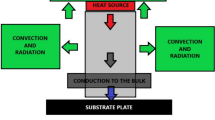An equation describing the exponential dependence of the yield point of metal that is to be drawn on the draft in the drawing operation is used to calculate the safety factor and the limiting and maximum drafts. The calculations are performed on the basis of simple formulas that are similar in form and are normally used to determine the axial drawing stress in the working cone of the draw plate. An increase in the strain-hardening coefficient and external friction is accompanied by an increase in the difference between the values of the safety factor and limiting and maximum drafts calculated by using different formulas for the axial drawing stress.
Similar content being viewed by others
References
S. I. Gubkin, Plastic Deformation of Metals [in Russian], Metallurgizdat, Moscow (1960).
I. L. Perlin and M. Z. Ermanok, Theory of Drawing [in Russian], Metallurgiya, Moscow (1971).
G. E. Arkulis, “The maximum draft in drawing,” in: Proc. Conf. on Hardware Manufacturing, Izd-vo TsBTI Chelyabinsk Sovnarhoz, Chelyabinsk (1961), pp. 36–42.
N. V. Sokolov, “Methods of calculating strain and energy consumption as a function of the strain-hardening of steel wire during its drawing,” Byul. NTO BMK, No. 7, 12–28 (1967).
Yu. S. Zykov, “Determining the maximum permissible drafts in drawing,” Stal, No. 4, 54–55 (1998).
A. S. Zheltov and A. N. Savenok, “Calculating the schedule for the rough and intermediate drawing of high-strength wire,” Stal, No. 11, 46–49 (1998).
V. A. Kulesha, N. A. Klekovkina, Kh. N. Belalov, et al., Production of High-Quality Hardware Items (Research and Practical Experience at the Beloretsk Metallurgical Combine), Beloretsk (1999).
G. N. Gur’yanov, “Calculation of axial drawing stresses with the yield point of the metal exponentially dependent on the draft,” in: Inter-Regional Symposium: Processes and Equipment for Metallurgical Production, MGTU, Magnitogorsk (2006), Vol. 7, pp. 216–218.
G. N. Gur’yanov, “Study of equations for determining axial drawing stress,” in: Proc. of a Symposium: Application of Mathematics in Economic, Technical, and Pedagogical Studies, MGTU,Magnitogorsk (2004),Vol. 2, pp. 179–184.
G. N. Gur’yanov, “Engineering methods of determining the axial stress in the drawing of circular products,” in: Proc. of a Symposium: Processing of Monolithic and Laminated Materials, MGTU, Magnitogorsk (2005), Vol. 32, pp. 46–57.
Author information
Authors and Affiliations
Corresponding author
Additional information
Translated from Metallurg, No. 10, pp. 73–75, October, 2008.
Rights and permissions
About this article
Cite this article
Gur’yanov, G.N. Evaluating the maximum draft and safety factor in wire-drawing. Metallurgist 52, 582–587 (2008). https://doi.org/10.1007/s11015-009-9096-5
Received:
Published:
Issue Date:
DOI: https://doi.org/10.1007/s11015-009-9096-5




